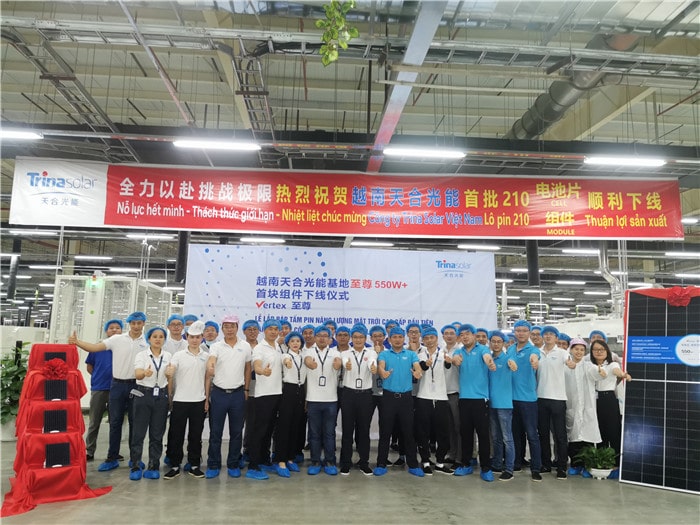Module manufacturer Trina Solar said the China Photovoltaic Industry Association (CPIA) is set to announce a set of standard dimensions for large format modules relying on the 210mm wafer launched by Zhonghuan Semiconductor in 2019.
The standard, according to Trina, will be set for different cell layouts as in the table below. Having a standard set of dimensions should make thing simpler, and therefore cheaper, for project developers and component suppliers. All of them have to deal with uncertainty over module sizes and electrical characteristics since the switch to larger wafer formats began to play out.
| Module standard dimensions (210mm wafer products) | |||||
| Cell type | Module type | Number of cells | Module length [mm] | Module width [mm] | Mounting hole distance in long side [mm] |
| Half cell | Single-glass, framed/ dual-glass, framed | 110 | 2384±2 | 1096±2 | 400/1400±1 |
| 120 | 2172±2 | 1303±2 | 400/1400±1 | ||
| 132 | 2384±2 | 1303±2 | 400/1400±1 | ||
| Source: Trina Solar | |||||
Toward standardization
The process began in May, when the CPIA brought together industry experts and representatives from across the supply chain to agree on a set of standards for products incorporating the 210mm wafer. Cell and module manufacturers including Trina Solar, Risen Energy, Canadian Solar, and Tongwei – all of which have opted to work with the 210mm wafer rather than the smaller 182mm product being promoted by Longi and others – took part in the CPIA event. They agreed to standardize various technical details of the modules including module dimensions, size and positioning of mounting system attachment holes, and cell spacing, among other details.
Modules will also be designed to meet the latest international standards including IEC 61730, published by the Switzerland-based International Electrotechnical Commission.
“This means 210mm module manufacturers, end users and system solution providers have achieved uniformity in technical issues,” said Trina Solar in a statement.
Trina said it expects the move for standardization to directly result in cost reductions for balance of systems components, and a more efficient supply chain. It said it also expects the manufacturing industry to be able to innovate and bring new processes to scale more quickly, and to bring down manufacturing costs.
This content is protected by copyright and may not be reused. If you want to cooperate with us and would like to reuse some of our content, please contact: editors@pv-magazine.com.









By submitting this form you agree to pv magazine using your data for the purposes of publishing your comment.
Your personal data will only be disclosed or otherwise transmitted to third parties for the purposes of spam filtering or if this is necessary for technical maintenance of the website. Any other transfer to third parties will not take place unless this is justified on the basis of applicable data protection regulations or if pv magazine is legally obliged to do so.
You may revoke this consent at any time with effect for the future, in which case your personal data will be deleted immediately. Otherwise, your data will be deleted if pv magazine has processed your request or the purpose of data storage is fulfilled.
Further information on data privacy can be found in our Data Protection Policy.